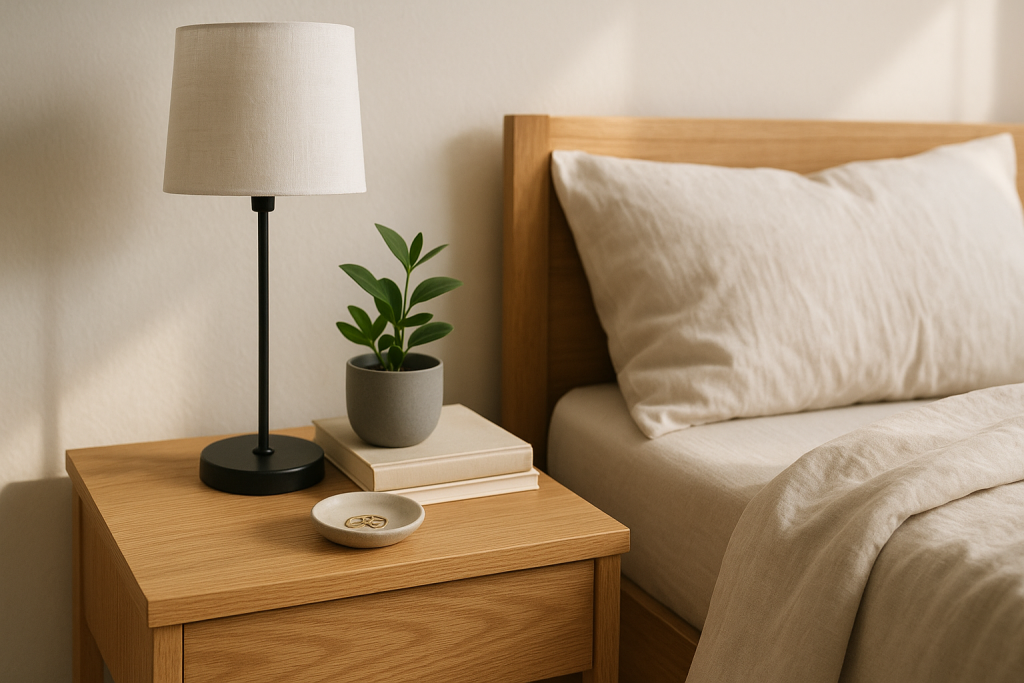
A simple wood nightstand is one of the most versatile pieces of furniture in any home. Its clean lines and natural warmth provide a perfect canvas, yet it’s often the last piece to receive any real design attention, sometimes becoming a forgotten repository for charging cables, water glasses, and half-read books. However, with a thoughtful approach, this humble piece can be transformed into a stunning focal point that elevates the entire aesthetic of a modern bedroom.
At FZA Home, our interior design experts believe that effective styling is about creating a balance between form and function. It’s about telling a story and crafting a space that feels both intentional and personal. A well-styled nightstand doesn’t just look good; it enhances your daily routines, providing calm and order where you start and end your day.
Transforming your simple wood nightstand from a purely functional surface into a curated design moment is easier than you think. This guide explores five professional strategies to style your nightstand, ensuring it perfectly complements a modern bedroom aesthetic.
Here are the five expert-approved ways to style a simple wood nightstand:
- Master the Art of Layering with Texture and Height
- Play with Strategic Light and Reflection
- Introduce Greenery and Organic Shapes
- Curate Functional and Personal Decor
- Create Dynamic Contrast with Color and Material
Let’s delve into each of these methods to unlock the full potential of your bedside table.
1. Master the Art of Layering with Texture and Height
Layering is a fundamental concept in interior design that involves combining different elements to create visual depth and interest. A flat, one-dimensional surface can feel sterile and uninviting. By layering objects of varying textures, heights, and depths on your wood nightstand, you create a rich, tactile experience that draws the eye.
Why Layering Matters for a Modern Look
Modern design often emphasizes clean lines and minimalism, but this doesn’t have to mean boring. Layering introduces complexity and warmth without creating clutter. The natural grain of the wood serves as the perfect base layer, a neutral foundation upon which other elements can shine. The goal is to build a composition that feels thoughtfully assembled over time.
How to Implement Layering Effectively:
- Vary Textures: The key to successful textural layering is contrast. The smooth, organic feel of the wood nightstand provides the perfect opportunity to introduce opposing materials. Consider placing a small, rough-hewn ceramic bowl to hold keys or jewelry. A coaster made of slate or marble can protect the wood surface while adding a cool, hard element. Even a stack of books can contribute, contrasting the smooth paper of a hardcover jacket with the rougher texture of an exposed spine. This interplay between smooth wood, soft textiles, cool stone, and sleek metal is what makes a design feel sophisticated.
- Play with Height: A common styling mistake is placing objects of a similar height next to each other, creating a monotonous, flat line. To avoid this, designers use the “visual triangle” principle. Your composition should have a tall point, a medium point, and a low point.
- Tall: This is typically the bedside lamp. Its height provides the anchor for the entire arrangement.
- Medium: A framed piece of art leaning against the wall, a vertical stack of two or three books, or a medium-sized vase can serve as the mid-level element.
- Low: A small decorative box, a candle in a holder, or a low-profile catch-all tray completes the triangle, grounding the arrangement.
- Create Depth: Don’t just line everything up against the wall. Create a sense of depth by placing items in the foreground, middle ground, and background. For instance, the lamp might sit towards the back corner, a picture frame could lean against the wall beside it, and a small decorative object could be placed closer to the front edge. This encourages the eye to move around the surface, making it feel more dynamic. Even when you need to style a small nightstand, these principles of layering are crucial for maximizing impact without overwhelming the space.
In our experience styling hundreds of bedrooms, a well-layered nightstand is the single most effective way to make a simple piece of furniture look high-end and intentional.
2. Play with Strategic Light and Reflection
Lighting is not merely functional; it’s a powerful tool for setting a mood and shaping a space. On a nightstand, the role of light extends beyond simple illumination for reading. Strategic use of light and reflective surfaces can make your bedroom feel larger, warmer, and more dynamic.
Choosing the Right Task Lighting
The bedside lamp is the workhorse of your nightstand, but its design is critical for a modern aesthetic. Bulky, traditional lamps can overwhelm a simple wood nightstand. Instead, opt for lighting that features:
- Sleek Silhouettes: Look for lamps with thin metal bases, minimalist geometric shapes, or sculptural forms. A lamp with a slim profile keeps the surface from feeling crowded.
- Wall-Mounted Sconces: For an ultra-modern, space-saving solution, consider installing a wall sconce above the nightstand. This frees up the entire surface for other decorative items and creates a clean, hotel-like feel.
- Appropriate Scale: The lamp should be in proportion to the nightstand and the bed. A lamp that is too small will look insignificant, while one that is too large will dominate the space. As a general rule, the bottom of the lampshade should be roughly at your eye level when you’re sitting up in bed.
The type of light bulb also matters. A warm white bulb (around 2700K) will cast a cozy, inviting glow that complements the natural warmth of the wood.
Harnessing the Power of Reflection
Reflective surfaces are a designer’s secret weapon. They bounce light around the room, creating a sense of brightness and depth. Introducing a reflective element to your wood nightstand can beautifully contrast with the matte finish of the wood.
- Metallic Trays: A polished brass, silver, or chrome tray is both functional and beautiful. It can corral smaller items like a watch, rings, and a lip balm, keeping the surface organized while its reflective quality adds a touch of glamour.
- Glass Objects: A simple glass vase or a decorative glass paperweight can catch the light from both the lamp and the window, creating beautiful refractions that shift throughout the day.
- Leaning Mirror: A small, framed mirror leaning against the wall at the back of the nightstand is an excellent way to create the illusion of more space. It reflects the light from the lamp and adds a layer of depth to the composition.
Combining a source of light with a reflective surface creates a synergistic effect. The light activates the reflective object, and the object amplifies the light, making the entire corner of your room feel more vibrant and alive. A lamp with a crisp white shade, for instance, can serve as a bright accent, and this principle is similar to how an off-white nightstand guide suggests using tone-on-tone elements for a sophisticated look.
3. Introduce Greenery and Organic Shapes
Nothing breathes life into a space quite like a touch of greenery. In a modern bedroom, where architecture can sometimes feel rigid, the soft, organic shapes of a plant provide a necessary and welcome contrast. Placing a plant on your wood nightstand connects the furniture back to its natural origins and introduces a calming, biophilic element into your most personal space.
Why Plants are Essential for Modern Styling
- They Add Life and Color: A splash of green is a simple way to introduce color without committing to a bold paint choice. It’s a living, breathing piece of decor that changes subtly over time.
- They Soften Hard Lines: Modern furniture often features strong, geometric lines. The gentle curves and unpredictable shapes of a plant’s leaves and stems soften these edges, creating a more balanced and harmonious environment.
- They Promote Well-being: Studies have shown that the presence of indoor plants can reduce stress and improve air quality, making them a perfect addition to the bedroom.
Choosing the Right Plant and Pot
The key is selecting a plant that is appropriate in scale and requires a level of care you’re willing to provide.
- Low-Maintenance Options: For the bedside, it’s best to choose resilient plants that can tolerate lower light conditions. Excellent choices include the Snake Plant (Sansevieria), the ZZ Plant (Zamioculcas zamiifolia), or a Pothos. These are famously hard to kill and look fantastic.
- A Simple Sprig: If you’re not ready for a potted plant, even a single stem of eucalyptus or olive branch in a minimalist bud vase can provide that desired organic touch. This is a simple, elegant solution that is easy to change out.
- The Container is Key: The pot or vase is just as important as the plant itself. For a modern aesthetic, choose containers made of concrete, matte ceramic, or textured stoneware. Avoid shiny, brightly colored plastic pots. The container should complement, not compete with, the natural beauty of the plant and the wood. The inherent elegance of materials like maple wood is wonderfully enhanced by greenery; when choosing a maple nightstand, designers often envision this exact pairing.
A high-quality faux plant can also be an excellent, no-maintenance alternative. Modern artificial plants are incredibly realistic and offer the same visual benefits of softness and color without any of the watering requirements.
4. Curate Functional and Personal Decor
A nightstand must serve its primary purpose: to hold the items you need within arm’s reach. The art of modern styling is to make these functional items part of the decor itself. This involves a process of careful curation—selecting items that are not only useful but also beautiful and meaningful.
The “Rule of Three”
This is a classic guideline in design which states that items arranged in odd numbers are more appealing, memorable, and effective than even-numbered groupings. A grouping of three objects is often the sweet spot for a nightstand. It feels balanced but not symmetrical, creating a more dynamic composition. A typical “Rule of Three” arrangement could be:
- Something Tall: The lamp.
- Something Living: The plant.
- Something Personal: A stack of books or a small decorative object.
Making Function Beautiful
Think about the items you use daily and find aesthetically pleasing versions of them.
- Curated Books: Instead of a random pile, choose two or three books with beautiful spines or covers that coordinate with your bedroom’s color scheme. They function as a stand for a smaller object and add height and intellectual weight to the arrangement.
- A Stylish Catch-All: A small ceramic dish, a shallow wooden bowl, or a small marble tray is perfect for holding your watch, rings, or earrings. It keeps these small items from getting lost and prevents the surface from looking cluttered.
- A Beautiful Carafe: A simple glass water carafe and cup can feel like a luxury hotel amenity, encouraging hydration while looking far more elegant than a plastic water bottle.
Adding a Personal Touch
Your nightstand is the most personal space in your home, and it should reflect that.
- Artwork: A small, framed photograph of a loved one or a favorite place adds an immediate personal connection. Leaning it against the wall is a more casual, modern approach than hanging it.
- A Scented Candle: Choose a candle in a chic vessel (like amber glass or matte ceramic) with a scent that helps you relax and unwind. It engages another sense and adds to the calming atmosphere.
- A Meaningful Object: This could be a smooth stone from a favorite beach, a small sculpture from your travels, or an heirloom. One or two such items can make the styling feel uniquely yours.
For nightstands with built-in storage, the drawers are your best friend. They allow you to keep clutter like charging cords, hand creams, and medications out of sight, preserving the clean, curated look of the surface. The practicality of storage is a key feature of many modern wood nightstands, and using those drawers effectively is essential for maintaining a minimalist aesthetic on top. Even a simple white 3-drawer nightstand relies on its storage to keep the visible surface pristine and stylish.
5. Create Dynamic Contrast with Color and Material
Contrast is what creates visual excitement. A room where everything is the same color and material can feel flat and uninspired. Your simple wood nightstand, with its warm, neutral character, is the perfect stage for creating powerful moments of contrast. This can be achieved through both material and color choices.
Juxtaposing Materials
The beauty of wood is its organic warmth. To highlight this quality, pair it with materials that are its opposite.
- Cool Stone: A marble coaster, a slate tray, or a granite bookend provides a cool, heavy contrast to the warmth and relative lightness of the wood. The veining in marble adds a layer of sophisticated, natural pattern.
- Sleek Metal: Introducing metallic elements immediately signals a modern aesthetic. This can be a lamp with a brass or black metal base, a silver-framed photo, or a small aluminum clock. The cool, rigid nature of metal is a striking counterpoint to the wood grain.
- Matte Ceramics: The earthy, often slightly rough texture of unglazed or matte-finished ceramic objects creates a subtle, sophisticated contrast. A simple vase or bowl in black, white, or grey stoneware can ground the arrangement.
- Clear Glass: The transparency and fragility of glass offer a beautiful contrast to the solidity of wood. It adds a sense of lightness and doesn’t take up visual space.
Injecting Pops of Color
While a neutral, monochromatic palette can be very calming and modern, a small, intentional pop of color can bring your nightstand styling to life.
- Through Accessories: This is the easiest and most flexible way to add color. It could be the vibrant spine of a single book, a vase in a deep jewel tone (like emerald green or sapphire blue), or a small, colorful decorative box.
- In Your Artwork: The small, framed piece of art is a perfect vehicle for color. Choose a piece with a color that is echoed elsewhere in the room, such as on a decorative pillow or in a rug, to create a cohesive look.
- The Lamp Base: A lamp with a colored ceramic or metal base can be a fantastic statement piece.
The key is restraint. In a modern bedroom, you don’t need a riot of color on the nightstand. One or two thoughtfully chosen colorful items are enough to create impact and draw the eye without disrupting the serene atmosphere of the space.
Conclusion: Your Nightstand, Your Style
A simple wood nightstand is far more than just a place to put your phone. It is a canvas for personal expression and a critical component of a well-designed modern bedroom. By applying these five principles—layering, lighting, greenery, curated function, and contrast—you can transform this everyday piece of furniture into a sophisticated and personalized style statement.
Remember that styling is a fluid process. The best arrangements feel authentic and lived-in. Use these guidelines as a starting point, but don’t be afraid to experiment, swap items out, and adjust the composition until it feels just right for you. Your nightstand should be a small source of joy and calm that greets you in the morning and sends you off to a peaceful sleep at night.
Frequently Asked Questions (FAQ)
Not necessarily. For a more traditional, symmetrical look, matching nightstands and lamps are a classic choice. However, for a more modern and eclectic feel, you can use two different nightstands. The key is to ensure they have a unifying element, such as a similar height, color family, or material, so they feel related rather than random. Styling them with similar, but not identical, objects can also create a beautiful, balanced asymmetry.
The ideal height for a nightstand is at or just slightly above the height of your mattress. A good rule of thumb is to aim for a surface that is within 2-4 inches of the top of your mattress. This makes it easy to reach for items from bed and ensures the overall composition looks visually balanced.
The key to a clutter-free nightstand is threefold: ruthless editing, using catch-alls, and maximizing drawer space. First, only keep absolute essentials on the surface. Second, use a decorative tray or bowl to contain small items like jewelry, lip balm, and watches. Third, use the drawers for anything that isn’t aesthetically pleasing, such as medications, chargers, and tissues.
While it depends on personal style, the most essential item is arguably a well-proportioned lamp. It provides necessary task lighting, serves as the primary vertical element to anchor the design, and its style (whether minimalist, industrial, or sculptural) sets the overall tone for the rest of the accessories.











